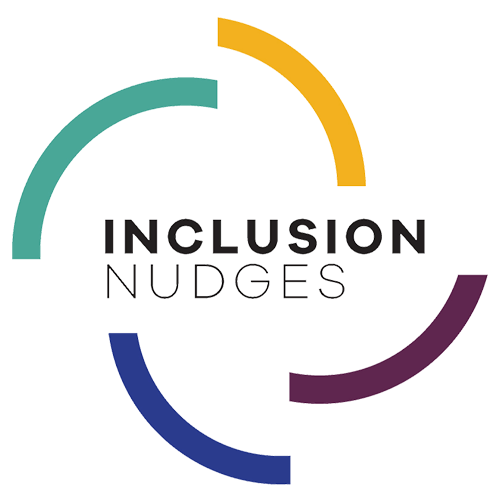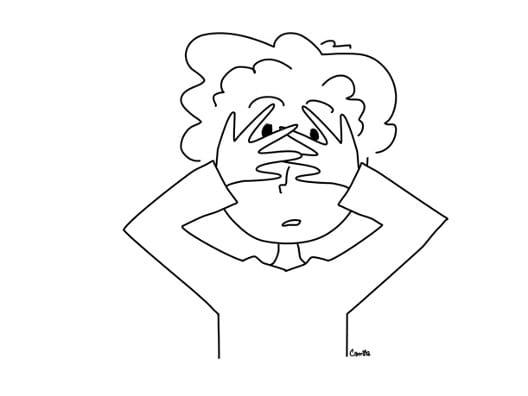More and more organisations have an increased focus on ‘belonging’ and ‘uniqueness’ in their efforts to create a truly diverse, inclusive, and innovative culture. Great! But rarely is this accompanied by a focus on diminishing shame – and that is really a shame because shame is a secret straitjacket prohibiting the development of a truly inclusive culture.
Something is holding us back
We (Lisa and Tinna) have listened to the stories of leaders, employees, and change makers at all levels working inside organisations and communities where we have been collaborating over the years. We recognise the signs of people feeling like outliers and the fear of not fitting in. We have felt this way many times as well in our lives and our work. Perhaps you have as well?
These feelings have impact on what we think, do, and say. People can doubt how to contribute, as they struggle with an inner sense of worthiness. Risk aversion can hold us back on sharing knowledge, perspectives, and ideas. We may doubt if our input is good enough to share with our negative inner voice asking if we are ‘smart enough’. Leaders can miss out on valuable insights from others by believing that they are supposed to have the right answers. This leads them to not ask for views from others – not because they don’t think diverse perspectives are important but because they fear it is a sign of weakness. This can reinforce a negative cycle of people self-silencing, having a fear of rejection, and perpetuating the overshadowing fear of not being ‘good enough’ or ‘smart enough’ or ‘not strong enough’, and much more. These feelings can get a strong grip on us, trigging power-reducing self-censorship and withholding. Why would we do this?
In our ongoing quest for understanding human nature, we have been curious about understanding some of the root causes of all this ‘holding back’. Shame is a concept that keeps coming up in the research as something common across all these behaviours, feelings, and perceptions that we have encountered in our work.
What research tells us about shame
All human beings are psychologically, emotionally, cognitively, and spiritually wired for connection, love, and belonging. We need this to survive. It gives purpose and meaning to our lives. It is the very core of living whole-hearted and healthy lives. And this matters to organisations that care about creating wellbeing of their employees and inclusive workplaces.
Another universal human trait is shame. Shame is the fear of disconnection and the fear of not being worthy of love and belonging. It’s the fear of “how I am…” or “what I do…” and “what I don’t do…” or “what I failed to do…” that makes us feel unworthy or not good enough for love, belonging, or connection.
Researcher Brené Brown has studied shame for decades and the definition of shame that emerges from her research is:
“Shame is the intensely painful feeling or experience of believing that we are flawed and therefore unworthy of love and belonging.”
(from her book Daring Greatly)
(from her book Daring Greatly)
And it’s real pain (not figurative speaking). The importance of social acceptance and connection is wired in our brain chemistry. Researchers have found that the experience of social rejection hurts in the same way as physical pain.
When we feel shame, several common patterns of destructive behaviours and strategies emerge, according to the research by Dr. Karen Horney.
These are to:
- ‘move away’: withdraw, hide, self-silence, isolate, keep secrets
- ‘move towards’: seeking to appease and please
- ‘move against’: gain power over others, be aggressive, blame, use shame to shame others
The problem is that these actions are strategies for disconnecting from the pain of shame, but these also move us away from connection, belonging, and love (the very core of shame). It’s a vicious circle. Research has proven that shame is strongly correlated with depression, aggression, bullying, suicide, addiction, and loneliness.
This feeling of shame is a fear so deeply rooted in the majority of people that it’s a secret companion of all interactions, thus influencing our ability to be inclusive of each other and of ourselves.
Now, here is an issue so powerful, that unless we deal with this in a more systematic approach as part of developing as human beings and as part of developing our organisations, workplaces, communities, and societies, we will not succeed in achieving wellbeing, connection, equity and inclusivity.
Shame differs for men and women (all genders identities)
While shame is universal, shame researchers have identified that the norms and expectations that trigger shame are organised by gender.
Across many societies, the research shows that the common stereotypical norms for how to be feminine in ‘the right way’ are being nice, thin, pretty, modest, quiet, and not owning your power. If you are a woman trying to move outside of these expectations, it can trigger the feeling of shame (not good enough, not pretty enough, not a good enough wife/mother, and more).
While the research shows that the common stereotypical norms for how to be masculine in ‘the right way’ are emotional control, risk-taking, dominance, disdain for homosexuality, winning, and the pursuit of status. For a man to avoid the dreadful shame triggers, he has to comply to the norms of being heterosexual, not feeling or being emotional, making money, use power to put everyone in their place, and climb to the top or die trying. (This topic is explored more in the blog article Men maintain norms they dislike.)
In various ways, we are all influenced by the deeply-rooted fear of being wrong, belittled, and less than. This is what stops us from taking the very risks of ‘putting ourselves out there’ and ‘showing up as who we really are’ which is the foundation for creating, innovating, developing, and making impact.
Shame and the fear of disconnection is holding each of us back from being our full potential and living fully. A culture that maintains such mental mechanisms stops organisations from developing and moving forward. This hinders the development of inclusive collaboration where we share our voices, our ideas, our perspectives, our concerns, our struggles, and our support.
When the shame straitjacket tightens, we hold ourselves and/or each other back.
Reduce the shame triggers to create an inclusive culture and belonging
We recognise the behaviours driven by shame in us and in people at all levels of the organisations. This issue of shame is a universal human condition that is so profound that we all feel it and are influenced by it. The most powerful feel it. The least powerful feel it. The ones with the highest status feel it, as do the ones with the lowest status. The people with the most power and privilege feel it, just like the people who are under-privileged. Shame is a powerful driving force in all people. And as such, creating a culture of belonging requires targeted efforts to diminish shame in all people. Only then will we be able to show up as who we are. Only then can we share our ideas and viewpoints without fearing exclusion. Only then can we stop pretending to have all the answers and start asking for those of others. Only then will we offer our help and ask for help without fear of being rejected.
This also makes a strong case for a change in the dominating tendency to focus Diversity, Equity, and Inclusion (DEI) work on minorities. This is about all of us.
Creating an inclusive culture has to focus on changing the norms to diminish the shame triggers, just as much as we focus on belonging and uniqueness.
An inclusive culture should be ‘like a car wash for our shame’, which is what Nadia Bolz-Weber calls out in her podcasts (‘The Confessional‘) where people from all walks of life share their personal stories of shame.
When listening to these stories and conversations it really does feel relieving and healing. Maybe it’s because as we listen, we recognise that painful feeling of shame. Knowing that others feel it too can set us free.
How to remove the straitjacket of shame
When we know about the drivers of shame, we can learn how to deal with these in constructive ways instead of destructive ways. We can all practice how to change the norms to diminish shame triggers and create cultures where honest and vulnerable conversations can take place so we can wash away feelings of shame and be our whole selves.
We can make sure these components are integrated parts of DEI efforts for all leaders, employees, and change makers in all organisations and all communities. Achieving DEI will require that we work on strengthening our abilities to be what shame researcher Dr. Brené Brown calls ‘shame resilient’. Here are a few of her recommendations for actions.
- Understand what is driving your feeling of shame (in you and in your culture)
Know and be conscious about what norms you are expected (by you and others) to comply with? Do you want to comply? Be conscious about what and who you want to be. Stand by that. - Talk to shame
Tell off your inner voice that belittles you. Shame derives its power from not being called out. - Reach out to others and share your experience. Shame withers when you talk about it. So, tell others. If people share their ‘shame’ experiences with you, make sure you let them know that you recognise that feeling. Talk about it together. Maybe laugh a bit – it can reduce the pain.
These Inclusion Nudges can support honest conversations and connections:
Telling Employees’ Stories For Inclusion in The Inclusion Nudges Guidebook
The Speech Bubble Intervention in The Inclusion Nudges Guidebook
Prompters To Connect & Increase Belonging in The Inclusion Nudges Guidebook
Previous blog articles relevant for this topic of wellbeing, connection, and shame:
Men maintain norms they dislike – they haven’t learned how not to
Stakeholder Inclusion – The Power of Speech Bubbles
‘Calling In’ Instead of ‘Calling Out’ Behaviour







